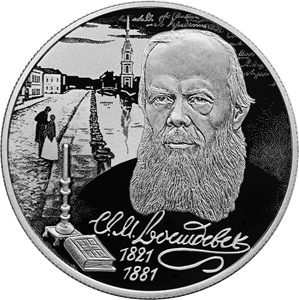Novelist Fyodor Dostoyevsky, Timed to the 200th Anniversary of his Birth (11.11.1821)
Obverse
the mirror field of the disc bears a relief image of the National Coat of Arms of the Russian Federation, over it along the rim there is the semicircular inscription ‘РОССИЙСКАЯ ФЕДЕРАЦИЯ’ (RUSSIAN FEDERATION) framed on both sides by doubled rhombuses, below under the coat of arms there are indications of the precious metal and its fineness on the left and the fine metal content and the mint trade mark on the right, at the bottom in the centre, in three lines, there is an inscription ‘БАНК РОССИИ’ (BANK OF RUSSIA), the denomination of the coin ‘2 РУБЛЯ’ (2 RUBLES), and the year of issue ‘2021 г.’ (2021).
Reverse
the mirror field of the disc bears relief images of the portrait of Fyodor Dostoyevsky, candles and a book against the background of Saint Petersburg sights and manuscript; there are inscriptions at the bottom: a facsimile of the writer’s signature and his life years ‘1821’ and ‘1881’ in two lines.
Authors
Designers: E.V. Kramskaya (obverse), A.V. Baklanov, National Artist of Russia (reverse).
Sculptors: A.A. Dolgopolova (obverse, reverse), A.V. Baklanov, National Artist of Russia (reverse).
Mint: Saint Petersburg Mint (СПМД).
Edge: 195 corrugations.
Discover more
Fyodor Dostoyevsky (1821–1881) is a Russian writer, philosopher and publicist. Corresponding member of the St. Petersburg Academy of Science since 1877. The classic of world literature.
Fyodor Dostoyevsky wrote his first novel ‘Poor Folk’ in 1845. The book was warmly welcomed by Nikolay Nekrasov and Vissarion Belinsky, the trend-setters in literature in those years. Nekrasov called the novice writer a ‘new Gogol’ and published his novel in the ‘St. Petersburg Collection’ almanac.
In 1849, the writer was arrested for reading in public the banned ‘Letter to Gogol’ by Belinsky. He was amnestied in 1856 after the coronation of Tsar Alexander II. Dostoevky wrote about his life in a prison camp in Omsk in ‘Notes from the House of the Dead’. This Russian novel became one of the first to tell about katorga (hard work in prison) and the life of prisoners, their daily routine and habits. For Dostoevsky’s contemporaries, ‘Notes from the House of the Dead’ became a real revelation.
In the years to follow, the author wrote the novel ‘The Insulted and the Injured’, story ‘A Nasty Anecdote’, newspaper story ‘Winter Notes on Summer Impressions’, and novella ‘Notes from Underground’.
In the 1860s, Dostoevsky published journals ‘Vremya’ and ‘Epoha’, which supported ‘Pochvennichestvo’, a specific idea of Slavophilism, which attempted to find a common platform in order to reconcile Westerners and Slavophils. At that period, the writer frequently went abroad, visiting Germany, France, England, Switzerland, Italy, and Austria. During those travels he developed a gambling addiction, which he later described in his novel ‘The Gambler’.
In the 1860-80s, Fyodor Dostoyevsky wrote novels that were later called his great five books, i.e. ‘Crime and Punishment’, ‘The Idiot’, ‘Demons’, ‘The Adolescent’, and ‘The Brothers Karamazov’. All of them, except ‘The Adolescent’, were included in Top 100 Works in World Literature by Norwegian Book Club, with the Norwegian Nobel Institute. The novel ‘The Brothers Karamazov’ became the last work by Dostoyevsky.
Source: https://www.culture.ru


